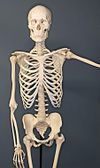
Back Menslike skelet Afrikaans ሥርዓተ አፅም Amharic هيكل عظمي بشري Arabic صكوليط ديال بنادم ARY মানুহৰ কংকাল Assamese Cadarma humana AST İnsan skeleti Azerbaijani Шкілет чалавека Byelorussian Костна система Bulgarian মানব কঙ্কাল Bengali/Bangla
| Human skeleton | |
|---|---|
 A human skeleton on exhibit at the Museum of Osteology, Oklahoma City, Oklahoma | |
| Details | |
| Identifiers | |
| Greek | σκελετός |
| TA98 | A02.0.00.000 |
| TA2 | 352 |
| FMA | 23881 |
| Anatomical terminology | |
The human skeleton is the internal framework of the human body. It is composed of around 270 bones at birth – this total decreases to around 206 bones by adulthood after some bones get fused together.[1] The bone mass in the skeleton makes up about 14% of the total body weight (ca. 10–11 kg for an average person) and reaches maximum mass between the ages of 25 and 30.[2] The human skeleton can be divided into the axial skeleton and the appendicular skeleton. The axial skeleton is formed by the vertebral column, the rib cage, the skull and other associated bones. The appendicular skeleton, which is attached to the axial skeleton, is formed by the shoulder girdle, the pelvic girdle and the bones of the upper and lower limbs.
The human skeleton performs six major functions: support, movement, protection, production of blood cells, storage of minerals, and endocrine regulation.
The human skeleton is not as sexually dimorphic as that of many other primate species, but subtle differences between sexes in the morphology of the skull, dentition, long bones, and pelvis exist. In general, female skeletal elements tend to be smaller and less robust than corresponding male elements within a given population. The human female pelvis is also different from that of males in order to facilitate childbirth.[3] Unlike most primates, human males do not have penile bones.[4]
- ^ Mammal anatomy : an illustrated guide. New York: Marshall Cavendish. 2010. p. 129. ISBN 9780761478829.
- ^ "Healthy Bones at Every Age". OrthoInfo. American Academy of Orthopaedic Surgeons. Archived from the original on 18 November 2022. Retrieved 6 January 2023.
- ^ Thieme Atlas of Anatomy, (2006), p 113
- ^ Patterns of Sexual Behavior Clellan S. Ford and Frank A. Beach, published by Harper & Row, New York in 1951. ISBN 0-313-22355-6